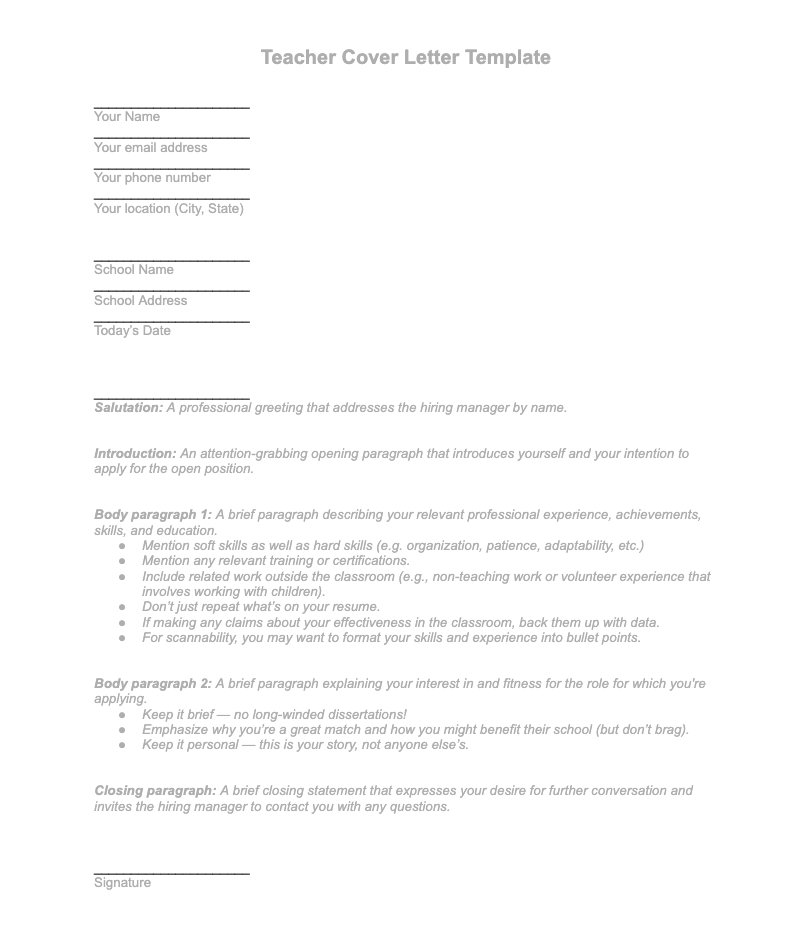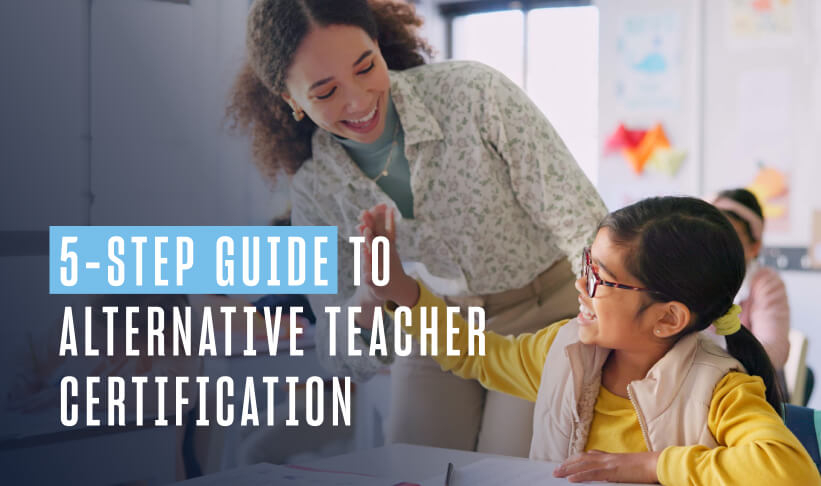Consider the following hypothetical scenario: You’re an outstanding teacher who is planning an upcoming move, or perhaps exploring new teaching opportunities in your current locale. You’ve got a solid background of experience, credentials and skills, plus many intangibles (unique talents, leadership acumen and passion, to name just a few).
So how do you communicate all of this to potential employers? And how can you showcase these qualities in a sharp, well-organized, visually appealing way that conveys your story and opens doors to new opportunities in the classroom and beyond?
Welcome to our mini Educator Resume Building Guide. Class is now in session.
Helpful for new and seasoned educators alike, this teacher resume guide will cover key insights regarding how to format and fine-tune your resume. We’ll share several strong teacher resume examples that you can use for inspiration — plus, a downloadable template you can use to build your own stellar resume!
How to Format a Teacher Resume
“Format” refers to two different ways of delivering your professional experience: page layout and file type. Aside from aesthetics or processing purposes, resume format is important because it prevents your resume from slipping through the digital cracks.
Many employers today use applicant tracking systems (ATS) to help them process resumes quickly, so they don’t have to sift through dozens of resumes one by one. According to Inc., “These systems automatically weed out most of the candidates who aren’t a close match for the role … It’s safe to say if you aren’t getting called for job interviews, ATS has something to do with it.” It’s important to understand resume readability and formatting so you end up in the 3 percent of online applicants who get contacted by a recruiter for any given job.
The most easy-to-process resumes — for both ATS and human eyes — follow one of these formats:
Reverse-chronological: This format highlights your career progression in an easy-to-scan timeline, making it ideal for recruiters and ATS. However, this format exposes time gaps and can be repetitive if you’ve held the same position at multiple schools.
Functional: This format focuses on your skills, which is ideal if you have limited teaching experience or gaps in your career. However, it’s been known to confuse potential employers and ATS.
Combination/hybrid: With an in-depth skills section and a small experience section, this format summarizes why you’re the best candidate for the job. However, it’s easy to structure this poorly, and it can look like you’re hiding a lack of work experience.
You’ll notice that each of the formats above contains a flaw. The truth is, words on a page cannot always accurately convey your entire professional experience. Only you can speak to that — and that’s what (hopefully) your interview is for.
That said, we recommend the reverse-chronological format for your educator resume because it proves you have practical knowledge and a steady career. This format should convey the story of your teaching experience in under six seconds, which is how long recruiters will take to scan your resume before knowing whether you’re the right fit.
Speaking of scanning, here are the most important elements you need to consider when creating your educator resume:
- Layout: A reverse-chronological conveys information with the most efficiency.
- Sections: Make sure each section of your resume is distinct and has white space around it to breathe.
- Font: Sans serif fonts like Verdana and Helvetica are recommended for body copy, as they are easy to scan. If you must choose a serif typeface, save it for the header (your name). Stay away from decorative fonts — flourishes, bubble letters and other ornamentation are simply distracting.
- Font size: Body text should be 11–12pts. Go 2–4pts. larger for section headings, and 6–10 pts. larger than that for your name. Again, you want the most important info to be easily scannable — name, job titles, dates.
- Subheadings: Identify each subsection with easy-to-read and straightforward titles: “Professional Experience,” “Education,” “Skills & Specializations,” and so on. You don’t want to confuse the ATS or resume screeners with witty headlines.
- Margins: Keep a 1-inch margin as a border to your resume. This leaves enough room for notes, plus it’s visually appealing.
- Line spacing: Single line spacing is recommended in resume body text; double spaces make it look like you’re trying to fill space.
- File type: Save and send or upload resumes as PDFs, unless the teaching job post or employer asks for Word docs. This prevents all but the savviest of users (or those with Adobe subscriptions) from editing your resume for any reason.
Must-Have Sections to Include on a Teacher Resume
Now that we’ve covered the visuals, let’s dive into the important content — your experience and skills.
These are the must-have sections to include on your teaching resume:
- Header: This should be its own section, distinct from the rest of the resume content. Your name is the “title,” followed by contact information like your email address, phone number, address and website or other professional links (if applicable).
- Introduction: This is a brief introductory statement that summarizes who you are as an educator, what your objectives are and what you might bring to this role. Keep it to 1–3 sentences or 3 lines total; you can always expand upon your experience and enthusiasm in your cover letter. Here’s an example:
“Elementary school teacher with over 5 years of classroom experience instructing at the 4th–6th grade levels, focusing on Life Sciences and prioritizing a whole-child approach. Increased 5th grade MCAS Science scores by 15% from 2017–2019. Seeking to bring enthusiasm and expertise in STEM engagements to the open 5th grade Science teacher role at Horace Mann Elementary School.”
- Work history: This is a detailed account of your teaching experience, preferably presented in reverse-chronological order. Include the names of your previous schools, range of tenure in years, grade levels taught, subject matter focus and any additional roles you held at the school. You may include brief descriptions of your accomplishments — not simply your responsibilities — in each role.
- Education: List your undergraduate and postgraduate schools and degrees, plus any noteworthy academic achievements at the postsecondary level. Do not include high school information if you are past the undergraduate level.
- Skills: This is a concise, objective list of teaching skills and abilities. Include both hard skills and soft skills, and make sure you demonstrate the application of these skills in your work history descriptions. (More on skills below.)
- Extra sections: You may want to leave room for awards, additional languages, community involvement, etc., if applicable and relevant to the position you are applying for. See below for more guidance here.
Additional Teacher Resume Sections to Consider
Of course, your teaching experience and skills are the primary qualifiers for any teaching position. However, don’t discount the importance of listing additional skills and awards, as long as they are relevant to the position. You never know — your intermediate German or recreational sports coaching may make you a candidate for additional open positions at a school, even if you don’t land the job you’re applying for.
- Certifications: For teachers, this section isn’t exactly optional. Potential employers want to know that you hold the appropriate licenses and certifications to teach children in their state. List any state teacher’s licenses first, followed by any supplementary private teaching certificates you may hold.
- Teaching association memberships: Are you affiliated with any teaching organizations or academic associations? This demonstrates a dedication to the profession and may help you build connections with potential employers or coworkers.
- Volunteer positions: Are you on any volunteer committees in your town? Do you offer free tutoring or mentor services? Do you regularly serve meals or stock shelves at the local food pantry? List anything you think might help round out your full professional picture.
- Language proficiency: Four years of French in high school doesn’t count; do mention if you possess proficiency or fluency in a language besides the school’s primary language.
- Hobbies & interests: This is typically covered in an interview, or perhaps even after you’ve been hired. However, list any hobbies that may be relevant to the position you are applying for. For example, if you are applying for an English teacher position, you can mention that you run a book club that focuses on 19th-century British literature.
WRITE A GREAT TEACHING RESUME
CONTENT AND FORMATTING TIPS FROM USD’S MASTER OF EDUCATION PROGRAM
DOWNLOADABLE TEMPLATE
APPLYING FOR TEACHING JOBS?
"*" indicates required fields

Top Skills & Keywords for Teacher Resumes
No matter the job, every potential employer likes to see a balance of “hard” and “soft” skills on a resume — hard skills being practical, job related abilities, and soft skills being your personal attributes that enable you to manage your work and relationships effectively.
In-demand hard skills for teachers include, but are not limited to:
- Excellent written and verbal communication
- Subject area expertise
- Age group/grade level expertise
- Classroom management
- Curriculum development
- Lesson planning
- Performance evaluations
- Specific teaching methods
- Computer skills
- Educational technology
- Online/virtual/hybrid teaching
- STEM/STEAM instruction speciality
- Differentiated instruction
- Digital literacy
- Leadership
- Adaptive teaching methods, such as project-based learning and scaffolding
Firsthand experience with the following classroom tools is also helpful:
While soft skills are sometimes harder to define, important soft skills for teachers include:
- Conflict resolution and diplomacy
- Critical thinking
- Time management
- Project management
- Leadership
- Creative problem solving
- Objectivity
- Patience
- Empathy and compassion
- Ability to stay calm under pressure
If you’re new to teaching and haven’t held many previous teaching positions, be honest! Everyone has to start somewhere, and embellishing your resume to make yourself seem more experienced will hold as much water as a pencil pouch. If you feel your lack of experience is holding you back from the right jobs, be sure to identify and include professional and academic references on your resume who can speak to your skill set (with their permission, of course).
Tips for Writing a Teacher Resume
There is no shortage of “top tips” out there for writing resumes. When it comes to teacher resumes, however, there are some things to keep in mind as you try to get in front of the right educators or administrators.
Make it instantly memorable.
As explained by Inc., your resume must be scannable in six seconds or less in order to capture a recruiter’s attention. Don’t spend hours crafting the perfect description of your previous jobs while forgetting to label them clearly. In order of importance, prioritize your resume header, section headings and font readability. Section headings especially are not the place to get “cute” — leave the clever quips for your second interview.
White space makes it easier to read.
Leaving lots of white space might sound boring, or like there’s not enough content to fill a page. However, white space makes text easier to read and scan. Maintain a 12- or 11-pt. font for body text, and don’t be afraid to stretch your resume to two pages if need be.
Tailor your resume to each job.
This is a standard rule for every type of profession, especially those in which people talk. Educators are well connected within the teaching community, and you don’t want one school to discover you’ve applied to multiple teaching jobs with a copied-and-pasted resume. Your introduction below your header should be customized to each job post, and so should your list of skills. Likewise, review each of your own job descriptions to see if you can highlight aspects that may speak to the specific position you’re applying for.
Show, don’t state.
Simply listing your job responsibilities doesn’t tell much of a story. You can still use bullet points to explain your prior positions, but instead of saying, “Taught a 5th grade class of 25 students,” try to frame your duties through a lens of your accomplishments in that position. For example, you could say instead, “Designed Life Science lesson plans around authentic STEM engagements, resulting in an average 25% increase in 5th grade test scores by the end of the school year.”
Support your experience with numbers.
You may have noticed that several examples in this article feature hard data. This is the best way to convey that your classroom impact had real results. Keep track of your students’ progress, and note where it improved as a direct result of your instruction. If you no longer have access to data from a previous job, you can reach out to the school to ask if they can share those records from your tenure.
Proofread and edit. Proofread and edit. Proofread and edit.
Any questions?
Teacher Resume Template
Now it’s time to polish up your teaching resume and start sending it out! Use our free teacher resume template to organize your experience according to best practices, or feel free to customize the layout in your own version. Above all, remember to be authentic — you love teaching for a reason, so use your resume to demonstrate!
If you’re looking ahead to your next teaching career move, or would like to learn more about expanding your educator skill set, a University of San Diego advisor can answer any questions you have. Our online Master of Education program is ideal for K–12 educators who want to make an even bigger impact in their classrooms and schools. Make an appointment with a USD advisor today to activate your teaching future.



